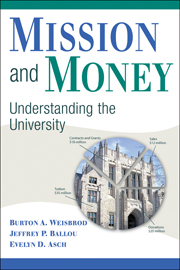Book contents
- Frontmatter
- Contents
- Illustrations
- Preface
- 1 An Introduction to the Higher Education Industry
- 2 The Higher Education Business and the Business of Higher Education – Now and Then
- 3 Is Higher Education Becoming Increasingly Competitive?
- 4 The Two-Good Framework: Revenue, Mission, and Why Colleges Do What They Do
- 5 Tuition, Price Discrimination, and Financial Aid
- 6 The Place of Donations in Funding the Higher Education Industry
- 7 Endowments and Their Management: Financing the Mission
- 8 Generating Revenue from Research and Patents
- 9 Other Ways to Generate Revenue – Wherever It May Be Found: Lobbying, the World Market, and Distance Education
- 10 Advertising, Branding, and Reputation
- 11 Are Public and Nonprofit Schools “Businesslike”? Cost-Consciousness and the Choice between Higher Cost and Lower Cost Faculty
- 12 Not Quite an Ivory Tower: Schools Compete by Collaborating
- 13 Intercollegiate Athletics: Money or Mission?
- 14 Mission or Money: What Do Colleges and Universities Want from Their Athletic Coaches and Presidents?
- 15 Concluding Remarks: What Are the Public Policy Issues?
- Appendix
- References
- Index
2 - The Higher Education Business and the Business of Higher Education – Now and Then
Published online by Cambridge University Press: 17 July 2009
- Frontmatter
- Contents
- Illustrations
- Preface
- 1 An Introduction to the Higher Education Industry
- 2 The Higher Education Business and the Business of Higher Education – Now and Then
- 3 Is Higher Education Becoming Increasingly Competitive?
- 4 The Two-Good Framework: Revenue, Mission, and Why Colleges Do What They Do
- 5 Tuition, Price Discrimination, and Financial Aid
- 6 The Place of Donations in Funding the Higher Education Industry
- 7 Endowments and Their Management: Financing the Mission
- 8 Generating Revenue from Research and Patents
- 9 Other Ways to Generate Revenue – Wherever It May Be Found: Lobbying, the World Market, and Distance Education
- 10 Advertising, Branding, and Reputation
- 11 Are Public and Nonprofit Schools “Businesslike”? Cost-Consciousness and the Choice between Higher Cost and Lower Cost Faculty
- 12 Not Quite an Ivory Tower: Schools Compete by Collaborating
- 13 Intercollegiate Athletics: Money or Mission?
- 14 Mission or Money: What Do Colleges and Universities Want from Their Athletic Coaches and Presidents?
- 15 Concluding Remarks: What Are the Public Policy Issues?
- Appendix
- References
- Index
Summary
Higher education is a large, complex, and changing industry. There is no single measure of the industry's size, but it enrolls some 19 million students and employs 3.4 million people, 3 percent of the entire U.S. service-sector labor force. A small number of schools are very well known, but the industry includes 4,314 degree-granting institutions (U.S. Department of Education, National Center for Education Statistics 2007b).
The higher education industry consists of public colleges and universities, private nonprofit schools, and a small but very rapidly growing number of private for-profit educational firms. About 39 percent of all U.S. degree-granting colleges and universities are public – four-year state universities and two-year community colleges – but as of fall 2006 they enrolled the large majority, 74 percent of all (undergraduate and graduate) students. There are as many nonprofit colleges and universities, about 38 percent of all schools, but their enrollments tend to be smaller than the public ones, accounting for 20 percent of all enrolled students. For-profit degree-granting schools are only 23 percent of the mix, enrolling over 6 percent of all students (see Tables A2.1 and A2.2 in the Appendix). The for-profit sector is vastly larger, though, when postsecondary schools that do not grant degrees are included. Nearly three-fourths of the 2,200 non-degree-granting schools in 2006 were for-profit, and this segment of postsecondary education is growing rapidly; its 330,000 students – an average of only some 160 students per school – is up from 189,000 as recently as 1997 (U.S. Department of Education, National Center for Education Statistics 2001, 2007b).
- Type
- Chapter
- Information
- Mission and MoneyUnderstanding the University, pp. 9 - 38Publisher: Cambridge University PressPrint publication year: 2008

